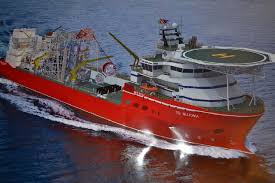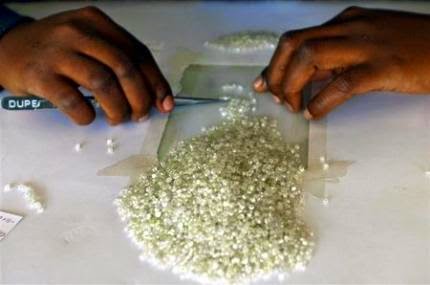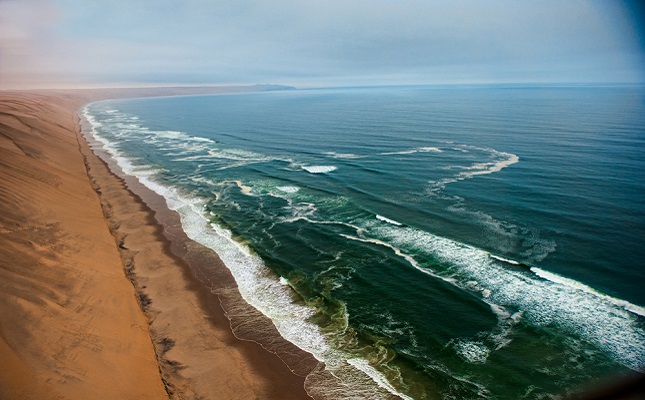Ocean Diamonds
We've frequently talked about diamonds mined from the earth and diamonds made in a lab. These gems also come from a place you'd least expect: the ocean.
That's the floor of the ocean, to be exact.
Off the coast of Africa, about 400 feet below sea level, a 285-ton vacuum machine sucks diamonds from the ocean floor. They are some of the highest quality diamonds being mined today.
 Millions of years ago these underwater diamonds were carried by the Orange River from the middle of the African continent to the Atlantic Ocean. Battering by wind, waves and rocks on the long journey seems to have broken up stones that had flaws and fissures. High-quality diamonds are the survivors.
Millions of years ago these underwater diamonds were carried by the Orange River from the middle of the African continent to the Atlantic Ocean. Battering by wind, waves and rocks on the long journey seems to have broken up stones that had flaws and fissures. High-quality diamonds are the survivors.
This is an opportune time for the industry to exploit a new diamond source. Global diamond production from land-based mines peaked in 2005. The best gems have been mined out, and continuing excavations bring diamonds of lower quality and smaller size. Some mines are being closed because the output no longer justifies the expense.
Deep-sea mining
 The underwater operation, called Debmarine Namibia, is a joint venture between De Beers and the government of Namibia. It takes advantage of new technologies to develop a unique system for reaping diamonds from marine deposits, both shallow and deep.
The underwater operation, called Debmarine Namibia, is a joint venture between De Beers and the government of Namibia. It takes advantage of new technologies to develop a unique system for reaping diamonds from marine deposits, both shallow and deep.
To retrieve the diamonds, a crawler vessel drills down about a foot and a half into the ocean floor, scooping diamonds from just below the surface. Then the company can switch to "vertical mining," with ships that drill to a depth of 400 feet or more to bring diamond-bearing gravel to the surface of the seabed.
Aboard the vessels are plants that mill the seabed rock with steel balls. The output passes under X-ray machines, and the diamonds are eventually poured into containers and sealed like so many cans of soup. A helicopter comes in to carry the diamonds to Windhoek, Namibia's capital, where the diamonds are sorted by hand.
 Environmentalists question the impact of the new techniques, since little is known about the deep ocean ecosystem. The company says the environmental impact of marine drilling is minimal compared with earth mining. "We don't use any chemicals," says Debmarine's operations manager, "and put all materials back, except the diamonds."
Environmentalists question the impact of the new techniques, since little is known about the deep ocean ecosystem. The company says the environmental impact of marine drilling is minimal compared with earth mining. "We don't use any chemicals," says Debmarine's operations manager, "and put all materials back, except the diamonds."
The Debmarine Namibia project has yielded some 16 million carats of the world's highest-quality diamonds. The seabed gems fetch the highest per-carat price of any of DeBeers' mines. It is said that about 95% of the output is gem quality, compared to about 20% from Botswana, the company's primary source of diamonds. DeBeers estimates it will be 50 years before this licensed offshore area is mined out.
FOR AGENTS & UNDERWRITERS
Regardless of where diamonds come from—deep in the earth or floor of the ocean—their value depends on their quality. Exercise basic precautions for all diamonds:
Be sure the appraisal describes the diamond in detail, including any treatments.
Be wary if the appraised valuation is significantly higher than the sale price.
For high-value jewelry, we suggest getting two appraisals from reliable appraisers who are independent of the seller.
The best appraisal includes the JISO 78/79 appraisal form, and is written by a qualified gemologist (GG, FGA+, or equivalent) who has additional insurance appraisal training. One course offering such additional training is the Certified Insurance Appraiser™ (CIA) course of the Jewelry Insurance Appraisal Institute.
All sizeable diamonds of significant value should have a certificate from a reliable lab. Labs can afford the instruments to precisely analyze cut proportions, to map inclusions, and to determine whether a diamond is mined or lab-made. We recommend the following labs and suggest that you use these links to verify reports you receive.
GIA Report Check
AGS Report Verifcation
GCAL Certificate Search
FOR ADJUSTERS
Scrutinize the appraisal and other documents to be sure a diamond is not treated or enhanced.
Check for terms that indicate a lab-made stone, such as: synthetic, man-made, lab-made, grown. Lab-made diamond has a value significantly less than mined diamond of similar quality.
If you don't recognize a brand name, or any other terms on the appraisal or other docs, consult a jewelry insurance professional.
If you are faced with a "narrative" (paragraph style) appraisal, it is helpful to use JISO 18 to analyze data from the documents you have and organize information from documents in a useful way.
When pricing a replacement, use descriptive data from the appraisal and lab report, or from your JISO 18 sheet; do not give the jewelry's valuation.
For damage claims, always have the jewelry inspected in a gem lab by a trained gemologist (GG, FGA+ or equivalent), who is hired by the insurer to verify the quality of the gem and determine whether it has been treated. Treated gems are not worth as much as untreated ones, and treatments that fail (i.e., fracture-filling) are not damage for which the insurer is liable.
©2000-2025, JCRS Inland Marine Solutions, Inc. All Rights Reserved. www.jcrs.com


